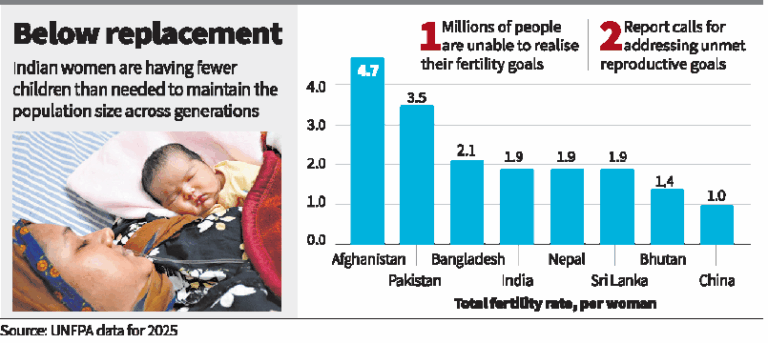State of the World Population Report 2025

- 12 Jun 2025
In News:
According to the United Nations Population Fund’s (UNFPA) State of the World Population Report 2025, India’s population has reached 146.39 crore as of April 2025, surpassing China (141.61 crore) to remain the world’s most populous country. Importantly, India’s Total Fertility Rate (TFR) has declined to 1.9, falling below the replacement level of 2.1.
Key Highlights:
Population Growth and Future Projections
- Current population (2025): 146.39 crore
- Projected peak: 170 crore in the next 40 years, after which population will begin to decline.
- Working-age population (15–64 years): 68%
- Youth population:
- 0–14 years: 24%
- 10–19 years: 17%
- 10–24 years: 26%
- Elderly population (65+ years): 7% (expected to rise steadily)
Fertility Trends and the Real Crisis
What is TFR?
- Total Fertility Rate measures the average number of children a woman is expected to have in her lifetime.
- Replacement level TFR: 2.1 (to maintain population size across generations)
- India’s TFR in 2025: 1.9, marking a demographic shift toward stabilization.
Fertility Divergence Across States:
- High TFR states: Bihar, Uttar Pradesh, Jharkhand
- Low TFR states: Kerala, Tamil Nadu, Delhi – already below replacement level
The Real Fertility Crisis (UNFPA View):
- The true concern is unmet fertility goals, not overpopulation or underpopulation.
- Barriers to achieving desired family size:
- Financial constraints (40%)
- Job insecurity (21%) and housing issues (22%)
- Lack of childcare (18%)
- Social/family pressures (19%)
- Modern concerns like climate change and shifting gender norms
Structural & Social Challenges
- Persisting inequalities in access to reproductive health across caste, income, and regional lines
- Youth bulge in LMICs (including India) offers demographic dividend but needs skill-building and employment opportunities
- Ageing population calls for future-proof policies on healthcare, pensions, and social security
Life Expectancy & Data Reliability
- Life expectancy (2025):
- Men: 71 years
- Women: 74 years
- Data drawn from: DHS, MICS, World Population Prospects 2024, Family Planning Indicators (2024)
- India’s decennial Census delayed to 2027, limiting official data updates since 2011
UNFPA Recommendations for India:
- Expand SRH (Sexual & Reproductive Health) Services: Universal access to contraception, safe abortion, and infertility care
- Tackle Structural Barriers: Affordable housing, childcare, flexible work policies, and women’s education
- Promote Reproductive Agency: Ensure informed choices on family planning for all, including LGBTQIA+ and unmarried individuals
- Balance Youth & Elderly Policies: Invest in youth employability while preparing for ageing-related challenges
